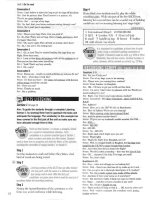gardening step by step b
Bạn đang xem bản rút gọn của tài liệu. Xem và tải ngay bản đầy đủ của tài liệu tại đây (27.32 MB, 204 trang )
Material previously published in Planting a Small Garden,
Low-maintenance Garden, Easy Pruning, and Vegetable Gardening
GARDENING
STEP BY STEP
Easy-to-follow advice f0r great results
Pruning a holly bush
199
If two branches are growing closely together at the top of
the plant and causing it to lose its conical shape, cut the
weaker one—or the stem that is least vertical—above a
shoot that is growing in line with the conical outline.
3
To ensure that this young holly remains an attractive
feature in the garden, it needs to be pruned annually,
first to form a conical shape, and then to retain it.
1
Remove some of the lower branches to create space under
the bush and a short, clear stem. This is known as “lifting
the skirt” and produces a bolder appearance.
2
Work all around the bush, trimming back any branches
that are too long, until you have a conical shape that is
symmetrical and pleasing to the eye.
4
200
Pruning shrubs and trees
How to prune an apple tree
When carefully managed, an
apple tree is highly ornamental,
providing decorative blossoms
in the spring and a wealth of
colorful fruit in the fall. Prune
in the summer or winter.
How to prune an apple tree
201
Only reduce the height of the tree yourself if you can reach
the top easily. Cut back any long branches by a half to
one-third, or to a suitable side branch that, if possible,
faces outward, to prevent crossing branches.
3
Start by removing any branches that are crowding the
center of the tree. This will allow air to circulate, which
reduces the risk of fungal infections during the summer.
Also remove any dead, diseased, or damaged branches.
1
Cut the branches back to the collar (see pp.170–171).
Make clean cuts with a sharp saw to reduce the risk of
infection entering the wounds. Don’t prune too hard, as it
stimulates leafy growth at the expense of flowers and fruit.
2
When pruning back to a side branch, make an undercut
first, and saw halfway through the stem. Then make the
final cut from above, sloping away from the side branch, to
meet the undercut. This prevents the branch from tearing.
4
202
Pruning shrubs and trees
How to prune an apple tree continued
Where pruning cuts have been made in previous years,
remove any short, weak, or crowded stems growing
around the wound. These are of no use to the tree and
divert energy from the main branches and flower stems.
7
The sloping cut you make after removing a branch (above)
allows moisture and rainfall to drain off the cut surface,
reducing the risk of rotting. The remaining side branch
should also point outward.
5
Shorten any long, thin, whippy growths by cutting them
back to short branches or spurs with a pair of pruning
shears. This encourages flower bud formation from
these branches.
6
Remove all branches that are crossing or are starting to
grow from the outside of the tree into the center. This
helps to prevent branches from rubbing against each other
in the future, thereby reducing the risk of disease.
8
How to prune an apple tree continued
203
Continue to work around the tree, removing unwanted
branches and taking care to make clean cuts. Step back
from the tree to ensure that you have created a balanced,
simple framework, with an uncongested center.
9
204
Pruning climbers
How to prune wisteria
Wisterias are vigorous plants, and during the summer
after they have flowered, the plants produce very long
tendril-like shoots that can block house windows or paths,
or swamp their supporting structures.
1
To keep your wisteria tidy, reduce these shoots by
two-thirds after the flowers have faded. This process may
have to be repeated several times during the summer
months as the plant continues to grow.
2
Summer pruning
Wisterias are beautiful plants for training
up house walls and other structures.
Prune these large, vigorous climbers
twice a year, once in summer to keep
the plant in check, and again in winter
to help stimulate flowering.
How to prune wisteria
205
In late winter, when the leaves have dropped, you will
be able to see the effects of your summer pruning. The
pruned stems will have developed new growth, which will
look lighter in color than older wood.
2
Also remove any stems that are growing into the eaves
of the house, under shingles, or around drain pipes or
down spouts. If left, they could cause damage to the
house structure.
3
Ensure that all stems are tied to sturdy wires on the house
or plant supports, as wisteria is not self-clinging. The plant
will look quite bare, but the buds will develop into a wall
of scented flowers in late spring or early summer.
4
Winter pruning
1
Spur prune (see pp.172–173) all the stems that you pruned
in the summer back to two or three healthy buds. These
buds will then swell to become flower buds in spring.
206
Pruning climbers
Cutting back clematis
Admired for their beautiful flowers,
clematis can put on an almost year-
round show. They are divided into three
groups, each with different pruning
needs, so work out which one yours
belongs to and follow these guidelines.
Clematis "Frances Rivis" (Group 1) Clematis "H.E.Young" (Group 2) Clematis tangutica (Group 3)
Clematis montana (Group 1) Clematis "Nelly Moser" (Group 2) Clematis "Etoile Violette" (Group 3)
Group 3
Group 3 clematis include the
small-flowered viticella and texensis
types, C. tangutica and its cultivars,
and some large-flowered hybrids.
They bloom from midsummer to fall
on new season’s growth and require
hard pruning in early spring, or you
can prune them more lightly.
Group 2
This group of early summer-flowering
clematis have large flowers that are
produced from the previous year's
growth. Many will also produce a
second flush of flowers in late
summer. Group 2 clematis require a
light prune in early spring. Prune back
stems to a pair of healthy buds.
Group 1
Group 1 clematis are vigorous plants,
and include C. montana, C. alpina,
and C. armandii. Flowering in late
spring on the previous year’s growth,
they require very little pruning. Prune
lightly immediately after they have
flowered to contain their size, and
remove any dead, diseased, or
damaged growth.
Cutting back clematis
207
New growth soon emerges
Pruning helps to show off seedheads Buds open below the pruning cuts
Prune above a pair of healthy buds Cut away excess growth in spring Prune lightly back to new growth
Pruning after planting
Help all groups of clematis to get
established by pruning them after
planting in spring, or in their first year
immediately after flowering. Reduce
the plant's height by one-half,
ensuring that you prune above a pair
of healthy buds. This encourages the
plant to produce growths from all the
buds on the stem below the pruning
cut, which will ultimately give you a
much stronger plant. It also
encourages root production, helping
to develop strong, healthy growth.
Take care when handling any clematis
as the shoots can be very brittle.
Pruning Group 1
Immediately after flowering, give
Group 1 clematis a light trim to help
contain the size of the plant and to
keep it looking tidy. Prune strong,
leggy new season's growths, cutting
above a pair of healthy buds. This
will also help to show off the plant's
attractive fluffy seedheads, but don't
prune too hard or you will remove
them. If a plant becomes too large,
occasionally prune all stems back to
6 in (15 cm) from the ground in early
spring. Montanas may not recover
from this treatment, so only carry out
drastic pruning if you have no choice.
Pruning Group 2
Prune Group 2 clematis in early spring
when the buds are already in growth
and new stems are visible. Work from
the top of the plant, pruning each
stem back to the first pair of healthy
buds or growths. Remove any dead,
diseased, or damaged wood. New
growths will appear along the pruned
stems, and these produce the flowers
in early summer. If the plant has
outgrown its site, hard-prune all
stems to 6 in (15 cm) from the
ground in early spring. It may not
flower during the coming summer,
or it may bloom later in the season.
208
Pruning climbers
How to prune a Group 3 clematis
Prune the growths hard back to one or two buds from the
ground, as shown. Always make straight cuts just above a
pair of healthy buds to reduce the risk of dieback.
3
This clematis has been grown over a large pyramid
support made from birch twigs. Start pruning by removing
all the loose growths that are covering the support.
1
Once all the stems have been removed from the support,
you will have better access to the base of the plant. Prune
back all long growths to give a manageable clump of short
stems before making your final cuts.
2
You will be left with a mound of growths about 6 in
(15 cm) high. To encourage healthy growth, add a little
fertilizer and mulch. The plant will then grow 6–10 ft
(2–3 m) and be covered in flowers during late summer.
4
The late-flowering Clematis x jouiniana
is extremely vigorous, and is suitable for
clothing large supports or growing
through substantial shrubs or small
trees. As it belongs to pruning Group 3,
it requires hard pruning in early spring.
How to prune a Group 3 clematis
209
If there are strong young growths coming from the base
of the plant, tie them into the rest of the clematis so that
they will not blow around in the wind and get damaged—
clematis stems are brittle and easily broken.
3
In early spring and starting at the top of the plant, lightly
prune back the main stems to fit the shape of the support.
As with any pruning, also remove dead, damaged, or
diseased stems as you work.
Then lightly prune the side stems back to the plant
support. This will maintain the shape of the plant and
encourage strong new growths that will flower in the
summer. Make sure all cuts are made above two buds.
2
When you have finished, the clematis should look as if it
has had a light haircut, since you have just trimmed it back
to the shape of the supporting structure.
4
1
Lightly pruning late-flowering Group 3
clematis, such as this Clematis tangutica,
encourages the plant to flower earlier.
Follow these simple steps to create a
cascade of beautiful yellow nodding
flowers throughout the summer.
210
Pruning climbers
Cutting back honeysuckle and ivy
Remove old, dead, damaged, or diseased stems. If your
plant is overgrown, cut all the stems back to about 6 in
(15 cm) from the ground. New shoots will soon appear
from the base, but you may lose the flowers that year.
2
In spring, contain the size of a honeysuckle by removing
long, straggly growths and reducing the overall height of
the plant by 12–20 in (30–50 cm).
1
Unless you gave the plant a hard prune, by late summer
it will produce an even covering of flowers. If the plant has
put on a lot of growth and is looking untidy, trim it again
immediately after flowering has finished.
3
Climbing honeysuckles (Lonicera) are
grown for their beautifully scented
flowers. Allow them to scramble over
shrubs and trees in the garden, or
encourage them to climb up supports,
such as fences or trellises.
Climbing honeysuckles are easy to grow, and produce masses
of sweetly scented blooms in the summer. As they age, plants can
become woody at the base, and look untidy and overgrown. Keep
them in check and flowering prolifically by pruning regularly.
Cutting back honeysuckle and ivy
211
Remove ivy growing up walls and into gutters. When
removing ivy from walls, you will reveal marks left by the
roots, which help the ivy to cling to the surface. Use a stiff
brush to remove the root residue.
3
The aim of pruning here is to reduce the plant’s spread
over the fence and to remove it from the tree trunk in
front. Ivy can collect a lot of dust and dirt, so wear a dust
mask when pruning if this affects you.
1
Working from the top of the fence panel, pull away long
lengths of ivy. When you are happy with the amount
removed, cut off the stems with pruning shears. Also cut
away any ivy growing on tree trunks or other plants.
2
The ivy has been cut back from the top of the fence by
about 18 in (45 cm) to allow room for regrowth. It has
also been removed from the tree trunk, resulting in a less
cluttered and lighter part of the garden.
4
Ivies are versatile evergreen climbers that
will grow in sun or shade, and adhere to
almost any support or surface. In late
spring or early summer, prune these
vigorous plants to contain their spread
and keep stems from clogging gutters.
212
Pruning climbers
How to prune a rose on a tripod
The plant is a mass of stems,
some of which are old and must
be removed, while younger
stems need to be tied in.
Before pruning
Climbing roses, such as this
R. “White Cockade,” can be
trained over a wooden tripod
to create a lovely focal point in
a small space. Prune the rose
in the fall or early spring.
How to prune a rose on a tripod
213
With the unpruned older stems that you left to cover the
tripod, spur-prune the previous season’s flowering stems
(see pp.172–173), and tie them into the tripod. These
spurs will produce flowering stems in the coming summer.
3
Start by removing the rose stems from the tripod support.
Cut all the ties that are holding the rose to the support,
and then carefully unwind the stems, working down from
the top of the plant.
1
Cut out any dead, damaged, or diseased wood. Then
remove about one in three of the oldest stems by pruning
them close to the base of the plant. Leave enough stems
unpruned to cover the tripod.
2
Tie back the remaining young flexible stems using garden
twine. To give the best coverage over the tripod, tie some
in a clockwise and others in a counterclockwise direction.
4
214
Pruning climbers
Pruning rambling and climbing roses
Use garden twine or special rose ties to tie in all the
stems. Bending flexible stems over and tying them onto
horizontal supports or wires encourages the production
of more flowering growths.
3
Remove one in three of the oldest flowering stems.
These growths will be quite thick and should be cut back
to almost ground level using a pruning saw or loppers.
1
Use sharp pruning shears to spur-prune the previous
summer’s flowering stems back to two or three healthy
buds (see pp.172–173). These will then produce flowering
stems during the coming summer months.
2
Do not attempt to prune a rambling rose in the summer. Tie in and
support the long, strong new growths that have been produced, so
that they are not damaged or broken. These are the stems that you
will be cutting back when pruning and training in the fall.
Ensure a mass of flowers each year by
pruning rambling and climbing roses
during the fall while their stems are still
quite flexible. If you don’t have time in
the fall, these roses can also be pruned
in late winter or early spring.
Summer maintenance
Pruning rambling and climbing roses
215
Tie all the remaining growths back onto the wires, and
try to cover as much of the wall as possible. You may find
some of the stems cross over each other, but this won’t be
a problem as long as they don’t rub.
3
Cut all the ties that are holding the rose to the wires and
pull the stems away from the wall. Remove one in three
of the oldest flowering stems. Do not remove any of the
strong new growths produced from the base of the plant.
1
Spur-prune last season’s flowering stems back to two or
three healthy buds (see pp.172–173 ) to encourage them to
produce more flowering stems in the months ahead.
2
Step back from time to time to ensure that you have tied
the stems in a fan shape over the wall. By the time
summer arrives, the plant will have produced more stems
covered in leaves and flowers and the wall will be hidden.
4
This climbing rose has been carefully
pruned and trained along horizontal
wires that have been attached to the
wall with vine eyes. Place galvanized
wire at about 12-in (30-cm) intervals up
the wall before planting your rose.
216
Where to start
Choosing a site
Growing vegetables in ideal conditions
is not always possible, particularly if
you have limited space, but it pays to
find a sunny spot that is sheltered
from the wind and easily accessible
for watering and weeding.
Sheltered or sunny walls
A wall that faces the sun provides plants with protection
from the wind and reflects the sun’s heat back onto your
crops during the day. It will also absorb heat and release
it at night when the air temperature falls. A sheltered
microclimate is ideal for growing heat-loving vegetables,
such as tomatoes, eggplants, and peppers, so if you have
one in your garden, make the most of it. Improve the soil,
create a raised bed, or position pots at the base of the
wall. Remember to keep plants well watered.
Tips for sunny walls
•
Add supports, such as wire mesh, to the wall to secure
tall and scrambling plants as they grow.
•
Take advantage of a sunny wall as the perfect backdrop
for tomatoes in a growing bag.
•
Be adventurous and try growing more unusual crops,
such as sweet corn and chili peppers.
Small vegetable beds
Make the most of a small space by planning your crops
carefully and squeezing as much variety into the plot as
possible. Many vegetables are attractive plants in their
own right, but add extra color to the beds by including
some flowers, too, which will not only look good but
also help attract pollinating insects. Planting vegetables
close together also means that there is little bare soil
on which weeds can establish, helping to minimize
maintenance, but crop yields may be slightly reduced.
Tips for small vegetable beds
•
Densely planted vegetables need rich soil, so work in
plenty of organic matter in fall.
•
Choose vegetable varieties with interesting colors and
forms to add drama to your beds.
•
Be wary of planting too close to tall hedges, which cast
shade and take moisture from the soil.
A greater range of vegetables can be grown by a sunny wall. Rows of vegetables packed tightly together will suppress weeds.
VEGETABLE GARDENING
Choosing a site
217
Colorful crops, like this chard, are easy to grow in pots.
Growing under cover
Protecting crops from cold and wet weather in a
greenhouse, cold frame, or under cloches gives them a
head start in spring, extends the growing season into fall,
and allows a range of tender vegetables to be grown that
may not perform well outdoors. Fitting large structures
into a small garden can be difficult, so consider whether
you have a suitable site before buying costly equipment.
Site greenhouses and frames in full sun, away from
overhanging trees, but sheltered from the wind as much
as possible. Plants under cover rely on the gardener to
provide adequate water and temperature control, which can
amount to a lot of work, so make sure you have the time.
Tips for growing under cover
•
Control greenhouse ventilation to regulate
temperatures and remove damp air that can encourage
disease. Automatic ventilation is a good investment.
•
Use cold frames and mobile cloches for raising
seedlings and protecting young plants.
•
Where there is no space outdoors, try sowing seeds
and growing heat-loving crops on a sunny windowsill.
•
Install a water supply, such as a rain barrel, next to the
greenhouse to make life easier.
Container growing
Filling pots, troughs, and window boxes with a range of
vegetables is one of the best ways for those with little
or even no garden to harvest their own homegrown
produce. Tomatoes, salads, dwarf beans, herbs, and some
root vegetables are just a few of the crops that will thrive
in containers and can make attractive displays on patios,
steps, and windowsills. Containers filled with good-quality
potting mix are also useful in gardens with very poor soil
or where soil-borne pests and diseases make vegetable
growing difficult. However, containers can be expensive
to buy and fill with potting mix, and without regular
watering and fertilizing, plants will not perform well, so
consider the practicalities before you begin.
Tips for container growing
•
Keep costs down and be creative by making your own
pots from galvanized metal bins or plastic containers.
•
Good drainage is vital to prevent soil from becoming
waterlogged, so be sure pots have holes in their bases.
•
Choose large pots, as they hold more soil, take longer
to dry out, and suit many vegetables well.
•
Look for vegetable varieties suited to container
growing, such as short, round carrots.
It is crucial to choose a site in full sun for your greenhouse.
218
Where to start
Making compost
Every gardener should
find space for a compost
pile or bin, as it turns
garden and kitchen waste
into a valuable source of
organic matter to dig into
soil or use as a mulch.
The final product Compost should
be dark brown with a crumbly texture
and pleasant, soil-like smell. The
decomposition of bulky organic
materials requires oxygen, moisture,
and the right balance of carbon- and
nitrogen-rich waste (opposite), which
means that careful management is
necessary. However, a successful
compost pile is easy to achieve.
Different compost bin designs Your first task is to
find a compost bin that suits the size of your garden and
the amount of waste to be broken down. It is best to have
two bins, to allow the contents of one to be aerated by
turning it into a second bin, which means that a new pile
can be started in the first. The type of bin you choose
depends on appearance, space, and cost considerations,
but ensure that it has a loose-fitting cover to prevent
waterlogging. Place your bin on bare soil, add
compostable material, and let nature do the rest.
Wooden bins look good and can be bought
or homemade. Choose a design with
removable front slats for easy turning.
Plastic bins are relatively cheap and simple
to install, but their design means that
turning the contents can be tricky.
Bins constructed from wire mesh are
particularly suitable for composting fallen
leaves to make leafmold.
Making compost
219
Making a compost trench
Kitchen waste, such as fruit and
vegetable peels, tea bags, and
eggshells can also be composted in
a long trench. The trench is best made
during the fall, when large areas of
soil are often bare and the waste has
time to break down before planting
begins in spring. Vigorous plants,
such as runner beans and squashes,
respond particularly well to the high
nutrient levels provided by kitchen
leftovers.
Dig a trench about 12 in (30 cm)
wide to one spade’s depth and fill it
with alternate layers of waste and
soil. Then add a layer of soil on top.
Allow at least two months before
planting over the trench. As with any
composting method, do not include
meat or cooked waste because it may
attract vermin.
What goes on the pile? Almost
all garden and kitchen waste can be
composted, except for diseased
material, perennial weeds, and meat
and cooked waste, which attracts
vermin. Nitrogen-rich (green) waste
aids decomposition, but this must be
balanced with carbon-rich (brown)
waste to open up the structure of the
pile and allow air to circulate. Aim to
add a 50:50 mix of green and brown
waste to your pile during the year.
Carbon-rich brown material adds bulk. Chop up woody material before adding.
•
Carbon-rich woody prunings and
hedge trimmings (which usually
need to be shredded), plant
stems, fall leaves, shredded
newspaper and cardboard.
•
Nitrogen-rich grass cuttings,
herbaceous plant material, weeds,
vegetable plants, fruit and vegetable
peels, tea bags, coffee grounds.
What to add
Scatter waste on the bottom of the trench. Fill with alternate layers of soil and waste.
220
Where to start
Water-wise gardening
Droughts and water metering can cause
problems during hot, dry summers, but
the solution is to know how to use
resources efficiently and to store your
own supplies.
Keeping plants healthy Plants in dry soil are susceptible
to disease and yield less, so it pays to keep soil moist.
Watering thoroughly so the moisture penetrates deep into
the soil is better than wetting the surface daily. Water in
the evening or early morning to minimize evaporation.
Water-wise gardening
221
Using gray water Water that has already been used
in the home is usually suitable for watering plants in the
garden. Normal household soaps and detergents do not
damage plants, but avoid bleaches and strong disinfectants.
Allow hot water to cool before applying it to the soil.
Storing rainwater Water can be
collected from the roofs of houses,
garages, sheds, and greenhouses,
and stored in rain barrels that have
spigots at their bases. These supplies
of rainwater are a valuable alternative
to city water or well water, although
during hot summer months, rainfall
rarely keeps up with demand.
Rain barrels are often easier to
install in a convenient part of the
garden than running a hose to the
area. Make sure that you set your
rain barrel on a stack of bricks, slabs,
or a specially made base, to allow a
watering can to fit under the spigot.
Although many gardeners dislike the
appearance of plastic barrels, they
are easy to disguise with ornamental
planting, such as grasses and bamboo
(right), or tall rows of runner beans.
Water the roots Pour water around the stem base,
beneath the plant’s foliage, so that it is absorbed into
the soil around the roots where it is needed. The shade
of the foliage also helps to prevent evaporation, and
neighboring weeds are not inadvertently watered, too.
222
Where to start
Cloches and cold frames
Protect crops from pests and bring on
their growth in cold weather by covering
them with cloches or growing them in
permanent cold frames.
Plastic bottle cloches Many plants benefit
from protection in cool spring and fall weather.
Commercial cloches can be expensive; large,
clear plastic bottles, cut in half and placed over
plants, are an effective alternative.









